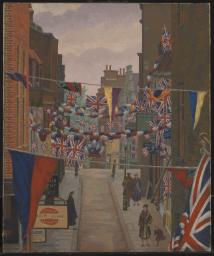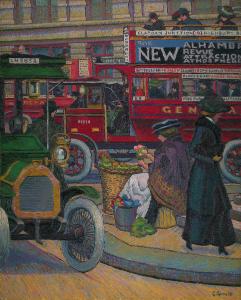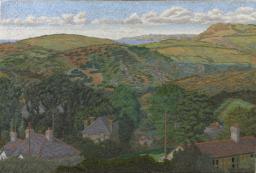Charles Ginner Snow in Pimlico 1939
Charles Ginner,
Snow in Pimlico
1939
Opposite Ginner’s window at 66 Claverton Street in Pimlico, London, a woman in a thick ochre sweater sweeps snow from the portico of a Regency style, puce-coloured house. It was Ginner’s first winter in Pimlico, where he stayed until his flat was damaged during the war. Painted footprints marking recesses in the snow on the pavement indicate periodic traffic, including a recent stop at the pillar box.
Charles Ginner 1878–1952
Snow in Pimlico
1939
Oil paint on canvas
406 x 356 mm
Inscribed ‘C. GINNER.’ in red-brown paint bottom right
Purchased (Knapping Fund) 1941
N05270
1939
Oil paint on canvas
406 x 356 mm
Inscribed ‘C. GINNER.’ in red-brown paint bottom right
Purchased (Knapping Fund) 1941
N05270
Ownership history
Purchased for 15 guineas (£15 15s) from the artist 1941.
Exhibition history
1939
The Camden Town Group, Redfern Gallery, London, March–April 1939 (10).
1939
Paintings and Drawings by Members of the Camden Town Group, Aberdeen Art Gallery, September–October 1939 (41).
1942
The Tate Gallery’s Wartime Acquisitions, National Gallery, London, April–May 1942 (38, as ‘St George’s Road, Pimlico’).
1942–3
A Selection from the Tate Gallery’s Wartime Acquisitions, (Council for the Encouragement of Music and the Arts tour), Royal Exchange, London, July–August 1942, Cheltenham Art Gallery, September 1942, Ashmolean Museum, Oxford, October 1942, Galleries of Birmingham Society of Arts, November–December 1942, Fitzwilliam Museum, Cambridge, January–February 1943, Victoria Art Gallery, Bath, February–March 1943, National Museum of Wales, Cardiff, March–April 1943, Manchester City Art Gallery, April–May 1943, Philharmonic Hall, Liverpool, May–June 1943, National Gallery of Scotland, Edinburgh, June 1943, Glasgow Museum and Art Gallery, Kelvingrove, July 1943, Laing Art Gallery, Newcastle upon Tyne, August 1943 (19, as ‘St George’s Road, Pimlico’).
References
1964
Mary Chamot, Dennis Farr and Martin Butlin, Tate Gallery Catalogues: The Modern British Paintings, Drawings and Sculpture, vol.1, London 1964, p.240.
2000
Wendy Baron, Perfect Moderns: A History of the Camden Town Group, Aldershot and Vermont 2000, p.175.
Technique and condition
Snow in Pimlico is executed in artists’ oil paints on primed stretched canvas. The support was prepared and supplied by Winsor & Newton, whose stamp marks the centre of the back of the canvas. There is also part of a stamp, which probably originally read ‘Made in England’, impressed into one of the four stretcher bar members. The cloth has a plain open weave with double threads in one direction. The cloth appears to have been sized and primed with a white probably oil-based primer, which extends to the edges and fills the weave interstices. The dimensions of the support conform to standard commercial size, which was available pre-stretched from Winsor & Newton. They supplied a range of readymade supports in this size and the cloth looks like a type ‘W.’ canvas: ‘a good, inexpensive, pure flax [linen] canvas of medium weight with a roughish grain, suitable for large scale work’.1
No trace of any initial drawing remains visible although it is likely that the composition was drawn out but is now obscured by paint (see also Tate N05276). Only very minor changes to the composition made during painting are discernible, such as in the area of the figure. The level of detail and handling of the paint are consistent across the whole surface of the canvas producing a homogenous finish. It is painted with opaque colour mixtures of oil paints rich in medium but sufficiently stiff for the dried paint to retain the texture and definition of the brush work (see also Tate T03096). The brushstrokes were applied with great deliberation and minimum disturbance to underlying or adjacent paint even though it was often still malleable. The handling produced occasional peaks of impasto and fine pinhole aerations where air was trapped in the mixtures. The direction, width and pattern of the brush strokes are used to describe the architectural forms and planes of the snow-covered road and pavement. Thus, where curtains are painted with vertical strokes and the walls with an interwoven network of vertical and horizontal strokes, the subtle creams, cool violets and umber tints of the snow are laid on following the diagonals of the perspective of the road and pavement and ledges of the buildings. There are some areas where fresh paint was applied over already partially dried paint, resulting in a rather matte finish, such as on the shadow of the square column next to the figure. It is not clear whether this was by accident or design but the particular surface quality it creates is clearly visible in the unvarnished surface of the painting (see also Tate N05306). There is little evidence of cracking in this particular work (see also Tate T03096), but along the bottom edge paint has been squashed and removed where an easel, canvas carrier or frame has pressed into the paint while it was still soft.
Roy Perry
June 2004
Notes
How to cite
Roy Perry, 'Technique and Condition', June 2004, in David Fraser Jenkins, ‘Snow in Pimlico 1939 by Charles Ginner’, catalogue entry, May 2005, in Helena Bonett, Ysanne Holt, Jennifer Mundy (eds.), The Camden Town Group in Context, Tate Research Publication, May 2012, https://wwwEntry
The view in this unusually small painting is from the second-floor window of 66 Claverton Street in Pimlico, where Ginner lived from 1938.1 He painted it during his first winter in the house, as it was exhibited in March 1939. The woman in No.73 opposite is brushing the snow from her steps and the pavement. The dark orange colour of her pullover is repeated in the curtains in the ground-floor windows. The niches at the bases of the porch columns are boot scrapers. Ginner plays with the pigment as both a representation and a material: the white paint sits like the white snow on top of the red pillar box, as do the painted footprints that mark recesses in the snow on the pavement.
Ginner frequently painted views from his own windows, as in From a Hampstead Window 1923 (Tate N03873), Flask Walk, Hampstead, on Coronation Day 1937 (Tate N05276) and Hartland Point from Boscastle 1941 (Tate N05306). This painting was presumably made from a drawing, following Ginner’s usual practice. The drawing is not known, but there are two detailed sketches of a similar view looking the other way along the street.2 The drawings and the painting include figures, which although small are ‘typical’ Londoners: sweeping the porch, chatting in the doorway, watering a window box, reading a tabloid newspaper while walking, and plodding along the pavement with a stick. In the Tate painting it is clear from the footprints that someone has been to the pillar box.
John Rothenstein took up the post of Director of the Tate Gallery in June 1938, and this was one of a number of purchases he made to catch up with modern British art. He clearly liked Ginner personally and published an essay on him in 1952. Rothenstein lived and worked in Pimlico and he recorded the visits he made to Ginner’s Claverton Street flat, enjoying the way that this affected his own vision of the area, noticing ‘the way the streets outside receded in long, grey, symmetrical vistas’ as they set off to dine in ‘some “eating-house” with shabby, comfortable red-plush seats’.3 It may be that Rothenstein saw Ginner at work on this painting. Ginner moved out of the flat after it was damaged by wartime bombing in 1940–1, but it seems likely that he continued to store his paintings there.
The work is listed in the artist’s third notebook with the title Snow in Pimlico,4 but it has been previously catalogued by Tate as Claverton Street: Snow in Pimlico, although Ginner did not use double titles. The Tate Gallery originally called it St. George’s Road, Pimlico, which does not exist in this area, though there is a St George’s Square nearby.
David Fraser Jenkins
May 2005
Notes
Ginner’s house and the pillar box opposite (which has been replaced) were still there in 2005, but the other side of the street has been rebuilt.
The first is Pimlico or Street Scene, watercolour and Indian ink, 370 x 268 mm (Royal Society of Painters in Water-colours), reproduced in The Glory of Watercolour: The Royal Society of Painters in Water-colours, exhibition catalogue, Bankside Gallery, London 1987 (116). The second is Street in Pimlico, watercolour and ink, 330 x 265 mm, Sotheby’s, 21 June 1995 (lot 17, reproduced).
Related biographies
Related catalogue entries
How to cite
David Fraser Jenkins, ‘Snow in Pimlico 1939 by Charles Ginner’, catalogue entry, May 2005, in Helena Bonett, Ysanne Holt, Jennifer Mundy (eds.), The Camden Town Group in Context, Tate Research Publication, May 2012, https://www






